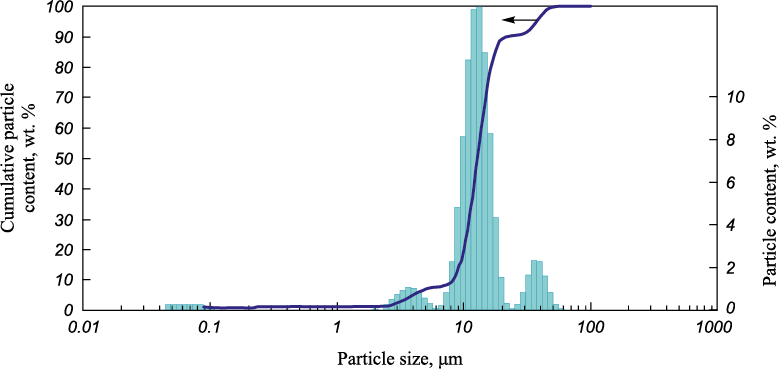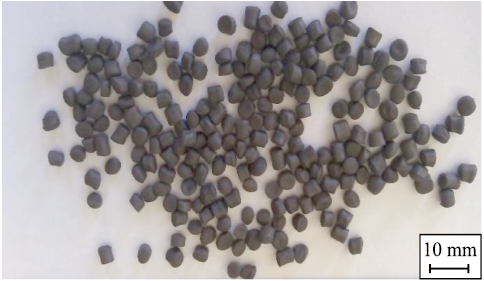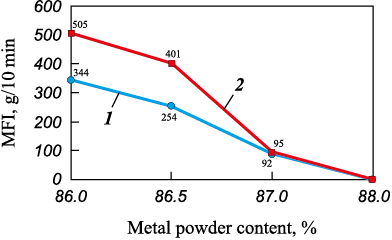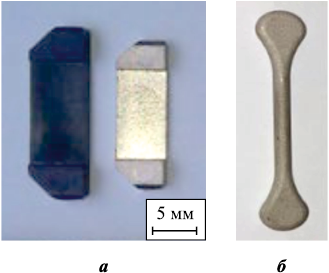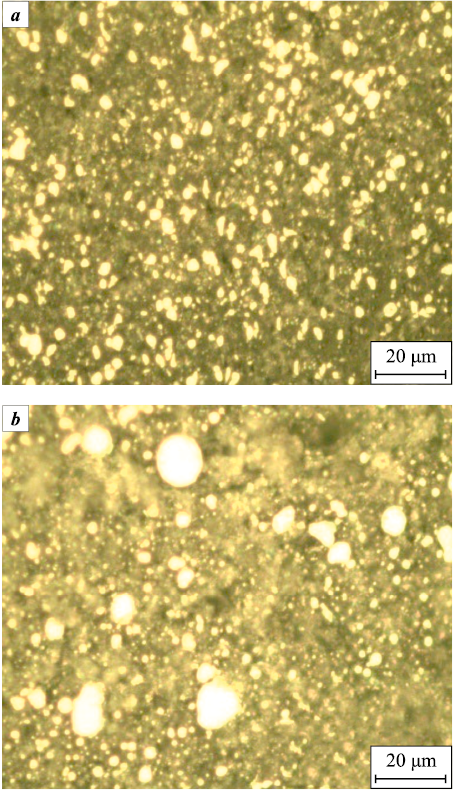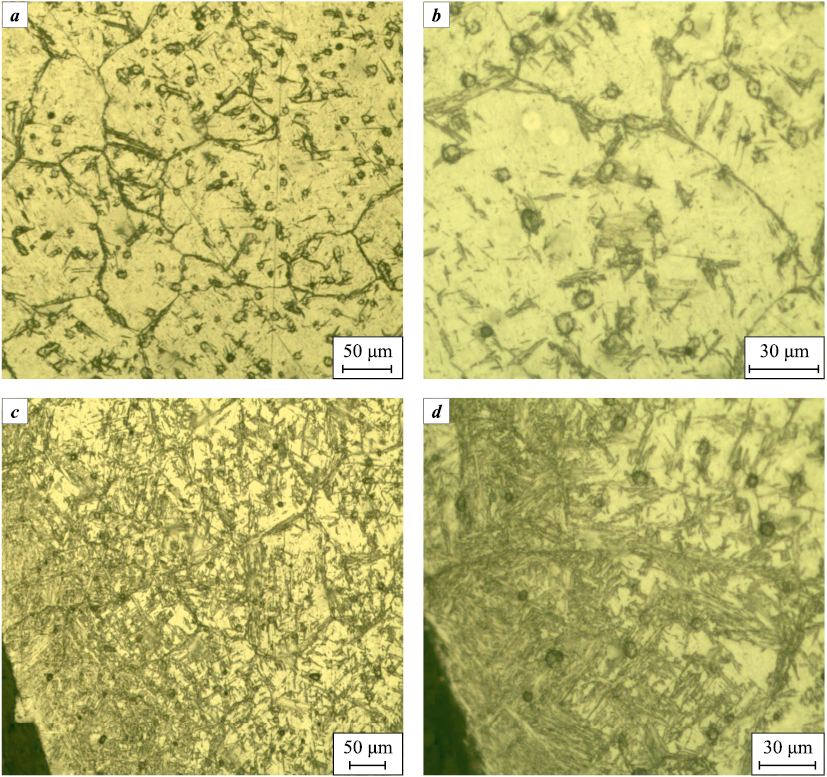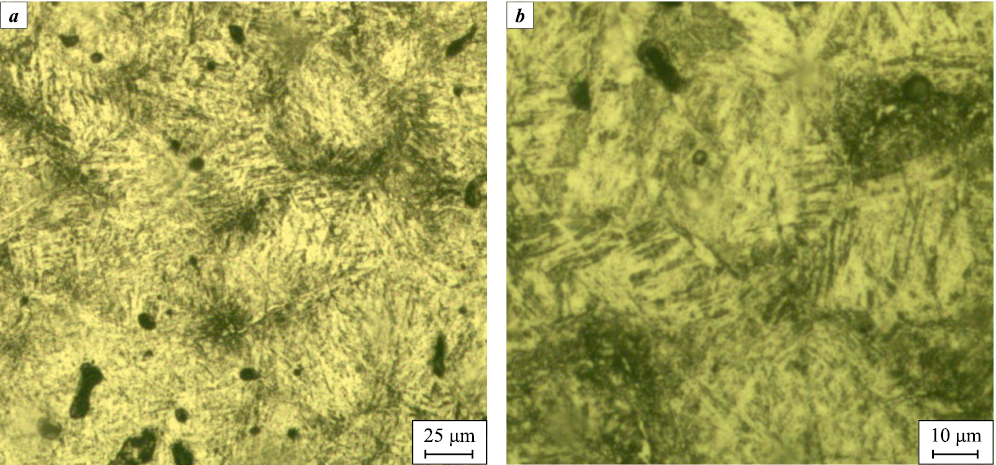Scroll to:
Development of a polyoxymethylene-based feedstock for metal injection molding using 09Cr16Ni4Nb stainless steel powder
https://doi.org/10.17073/1997-308X-2025-3-15-24
Abstract
Stainless steel powders are among the most widely used raw materials for the production of small, high-precision engineering components by metal injection molding (MIM), a process that combines metal powders with molten polymer binders. This study focuses on the development of feedstock composition and processing parameters for MIM production using domestically sourced components: a martensitic stainless steel powder grade 09Cr16Ni4Nb, a polyoxymethylene-based binder, and processing additives including stearic acid, beeswax, and low-density polyethylene. The starting stainless steel powder had a spherical morphology with a predominant particle size range of 8–23 μm. Scanning electron microscopy, melt flow index (MFI) testing, and helium pycnometry were employed to investigate the microstructure, rheological behavior, and physical properties of the resulting feedstock granules. Dependencies of MFI on the feedstock composition, metal-to-polymer ratio, type and content of additives, and particle size distribution of the metallic phase were established. The optimal feedstock formulation was determined experimentally. The microstructure and physical properties of sintered samples produced from the developed feedstock were evaluated and compared with those made from imported Catamold® feedstock. It was demonstrated that standard heat treatment modes are suitable for MIM-fabricated parts, as the phase transformation behavior of the studied steel does not differ from that of conventionally processed materials. The results confirm that components manufactured from the in-house feedstock comply with relevant regulatory standards and match the performance of their imported counterparts.
Keywords
For citations:
Parkhomenko A.V., Amosov A.P., Pastukhov A.M. Development of a polyoxymethylene-based feedstock for metal injection molding using 09Cr16Ni4Nb stainless steel powder. Powder Metallurgy аnd Functional Coatings (Izvestiya Vuzov. Poroshkovaya Metallurgiya i Funktsional'nye Pokrytiya). 2025;19(3):15-24. https://doi.org/10.17073/1997-308X-2025-3-15-24
Introduction
The metal injection molding (MIM) process integrates the principles of powder metallurgy and polymer injection molding. This method involves the preparation of feedstock – a homogeneous mixture of fine metal powders and polymer binders – followed by injection molding of green parts, subsequent binder removal, and sintering to produce fully dense metallic components. MIM-produced parts combine the geometric complexity and dimensional precision typical of polymer-molded products with the mechanical strength inherent to metals [1]. A key advantage of MIM technology lies in its capability for high-volume production of small, intricately shaped components that generally require no further machining.
In metal injection molding, the starting material is a feedstock – a composite granulated material consisting of fine metal powders uniformly mixed with a polymer binder. Optimization of the feedstock composition is a critical step in ensuring the quality and efficiency of the MIM process. The typical volume fraction of metal powder in the feedstock ranges from 50 to 65 %, although it can be increased to 80 % or higher. However, increasing the metal powder content leads to a rise in the feedstock’s viscosity, which may negatively affect the injection molding process [2; 3].
The characteristics of metal powders have a significant impact on the properties of final parts produced by the MIM process [4]. One of the key requirements for such powders is low surface energy, which facilitates effective mixing with the binder. This requirement is best met by powders composed of spherical particles with diameters up to 50 μm, preferably in the range of 1 to 5 μm. For example, a granulometric analysis of BASF’s Catamold® 42CrMo4 feedstock revealed that it consists of fine spherical metal powders with particle sizes ranging from 1 to 5 μm [5].
Other important powder characteristics include particle shape, particle size distribution, and surface morphology. Particle shape affects the rheological behavior of the feedstock and the dimensional stability of the molded part during thermal processing. Irregularly shaped particles can enhance the mechanical strength of the part after binder removal, but they reduce packing density and increase feedstock viscosity. This, in turn, requires a higher binder content and may lead to excessive porosity in sintered components. The same applies to spherical particles with rough surfaces featuring protrusions and indentations [6]. Smooth, spherical particles are considered optimal for MIM technology due to their high packing density and low flow viscosity, although they may result in reduced strength of the debound parts. The most favorable performance in MIM is often achieved using mixtures of spherical and irregularly shaped particles [7; 8].
The average particle size of the powder is another critical parameter in MIM technology. Fine powders tend to agglomerate more readily, which makes them particularly suitable for MIM applications [9]. However, the minimum particle size is limited by the flowability of the powder–binder mixture: at elevated temperatures, smaller particles reduce the flowability of the feedstock, which negatively affects the injection molding process. The maximum particle size, on the other hand, influences the densification of the sintered component: larger particles decrease the likelihood of achieving high final density [10]. Improvements in the microstructure of sintered parts can be achieved by using powders with a bimodal particle size distribution, combining coarse and fine particles to reduce porosity by filling the interstitial voids between larger particles. As shown in [11], a broad particle size distribution enhances packing efficiency but complicates feedstock homogenization, thereby impairing uniform powder–binder dispersion during molding. By carefully controlling the shape and size of both spherical and irregular particles, it is possible to achieve high packing density and tailor the properties of the final components [12].
The range of metals used in metal injection molding is diverse and includes low-alloy steels, heat-resistant and corrosion-resistant alloys, as well as materials based on copper, nickel, cobalt, and titanium. In addition, intermetallics, magnetic alloys, carbides, and borides are also employed [13]. Unlike conventional metalworking methods, where up to 80 % of the material may be lost as machining waste, the MIM process achieves a material utilization rate of approximately 99 %, which is particularly advantageous when working with high-cost metals such as stainless steels and titanium alloys. Recent international studies frequently report the use of spherical 17-4PH martensitic stainless steel powders [14–21]. For example, in [19], a gas-atomized 17-4PH stainless steel powder with particle sizes ranging from 4.8 to 30 μm was employed. In [20], a water-atomized 17-4PH powder with near-spherical morphology was used. The authors of [21] utilized four different 17-4PH stainless steel powders varying in both particle size and morphology.
The binder plays a critical role in the metal injection molding process, as it must ensure low viscosity at high powder loading and remain chemically inert to facilitate effective mixing. Commonly used binders include low-molecular-weight polymers or waxes. Additives are often incorporated to adjust the binder’s properties. One of the essential requirements for the binder system is its ability to provide sufficient viscosity to enable the molding of components with complex geometries. Another mandatory property is its ability to adequately wet the surface of the powder particles to optimize mixing and ensure proper shaping of the final part. To this end, surfactants such as titanates, silanes, phosphates, and stearates are introduced into the process to reduce the viscosity of the feedstock and increase solid loading by promoting interfacial adhesion between the powder and the binder.
Given that the MIM process is intended for manufacturing components with complex geometries, one of the essential requirements for binder components is adequate strength. High strength performance is typically achieved using polyoxymethylene (also known as polyacetal or polyformaldehyde) in the binder formulation. POM-based binder systems provide excellent mold filling and ensure the dimensional stability of molded parts. Components produced from such feedstock exhibit high strength and hardness, favorable fatigue properties, and minimal shrinkage upon sintering [22–24]. One of the most widely used binder systems in MIM technology consists of a composition based on polyoxymethylene, low-density polyethylene, and stearic acid. These components help preserve part geometry and structural integrity, even under conditions of increased porosity following polyoxymethylene removal [4].
One of the most critical properties of MIM feedstock is its homogeneity, which is essential for minimizing phase separation during injection molding and for achieving isotropic shrinkage during debinding and sintering. Inhomogeneous feedstock can lead to visible defects in the final sintered part, as well as excessive porosity, cracking, and distortion. To achieve the required level of homogeneity, various types of mixers, crushers, mills, and screw extruders are employed. Effective mixing requires uniform shear throughout all regions of the mixing chamber. The most efficient solution is the use of a twin-screw extruder, which provides intensive shear combined with a short residence time of the metal–polymer compound at elevated temperatures [1].
To optimize the powder–binder composition and to select appropriate additives and modifiers during feedstock preparation, rheological tests are conducted to evaluate melt flow behavior. The molten feedstock is extruded through a die/nozzle of specified diameter under standard conditions to determine the melt flow index (MFI). This parameter characterizes the material’s ability to flow into the mold cavity during injection.
The aim of the present study was to develop a domestically produced metal powder feedstock based on stainless steel powder and a polyoxymethylene binder for the fabrication of steel parts by metal injection molding. In addition, the study aimed to establish relationships between the composition and structure of the metal–polymer compound, its processing parameters, and the physical, mechanical, rheological, and performance characteristics of both the feedstock and the resulting sintered MIM components.
Materials and methods
To develop the feedstock, a spherical metal powder of low-carbon stainless steel grade 09Cr16Ni4Nb was used. The powder was produced by gas atomization and supplied by Polema JSC (Tula, Russia). The selected polymer binder was polyoxymethylene (POM) grade Tekhnaset A-110 (TU 2226–020–11517367), manufactured by Polyplastic Research and Production Company (Moscow, Russia). The surfactants used in the formulation included technical-grade stearic acid T-32 (GOST 6484–96), produced by Nefis Cosmetics (Kazan, Russia), and natural beeswax (GOST 21179–2000). To retain the structural integrity of the molded part after binder removal, low-density polyethylene (LDPE) grade 15813-020 (GOST 16337–22), produced by Kazanorgsintez PJSC (Kazan, Russia), was incorporated as a backbone binder component.
The particle size distribution of the metal powder was measured using an Analysette 22 Compact laser particle size analyzer (Fritsch GmbH, Germany). The microstructure of the starting materials and of the feedstocks developed from domestically sourced components was examined using a JSM-6390A scanning electron microscope (JEOL, Japan). The rheological properties of the feedstock were evaluated in accordance with GOST 11645–73 using a Modular Melt Flow 7026 instrument (Ceast S.p.A., Italy) at a temperature of 190 °C and a load of 21.6 kgf. Density and inhomogeneity were measured with an AccuPyc 1340 helium pycnometer (Micromeritics, USA). The hardness of sintered parts was measured according to GOST 9013–59 using a WPM hardness testing machine (WPM Leipzig, Germany). Compression and tensile tests of sintered samples were carried out in accordance with GOST 18227–85 using an Instron 5988 universal testing machine (USA).
Results and discussion
The starting 09Cr16Ni4Nb stainless steel powder exhibited a particle size distribution as shown in Fig. 1. The majority of the particles ranged from 8 to 23 μm in diameter, which meets the key requirements for metal powders intended for MIM feedstock production.
Fig. 1. Particle size distribution of the 09Cr16Ni4Nb stainless steel powder |
To determine the optimal ratio between the metallic and polymeric components, eight batches of feedstock with varying compositions were prepared. The feedstock was produced following a specific sequence of component mixing: stearic acid (SA) or beeswax (BW) was first added to the 09Cr16Ni4Nb stainless steel powder, followed by low-density polyethylene (LDPE), and finally polyoxymethylene (POM) was introduced. The granulation process was carried out under the following conditions:
| Screw temperature, °С. . . . . . . . . . . . . . . . . . 160–180 | ||
| Screw rotation speed, rpm . . . . . . . . . . . . . . . 120–130 | ||
| Pelletizer cutter speed, rpm . . . . . . . . . . . . . . 1100 |
The appearance of the resulting feedstock granules based on 09Cr16Ni4Nb stainless steel powder is shown in Fig. 2.
Fig. 2. Appearance of the 09Cr16Ni4Nb feedstock granules |
The results of melt flow index (MFI) and density measurements for the experimental batches of feedstock are presented in Table 1.
Table 1. Rheological and physical properties of feedstock granules
| |||||||||||||||||||||||||||||||||||||||||||||||||||||||||||||||||||||||||||||
Beeswax and stearic acid were used as surfactants. The compositions containing beeswax (formulations 5–8) exhibited higher melt flow index (MFI) values, which, in turn, resulted in lower feedstock density. The MFI trends for the investigated feedstock formulations are shown in Fig. 3.
Fig. 3. Dependences of MFI on metal powder content in the feedstock |
The most promising feedstocks were formulations 2 (with stearic acid) and 6 (with beeswax), which are recommended for further investigation.
Green parts of a component referred to as the “substrate” were molded using feedstock 2. Fig. 4, a shows the green part (left) and the sintered “substrate” component (right). For comparative analysis, parts were also produced from imported Catamold® Stainless 17-4PH feedstock. Additionally, standard test samples were prepared for microstructural examination and mechanical property testing (Fig. 4, b), with dimensions in accordance with GOST R 59651–2021.
Fig. 4. Appearance of samples made from the developed feedstock |
Injection molding of green parts using the 09Cr16Ni4Nb stainless steel powder was performed on a thermoplastic injection molding machine under the following conditions:
Mold temperature, °С . . . . . . . . . . . . . . . . Injection pressure, MPa . . . . . . . . . . . . . . . Дозировка (навеска), см3 . . . . . . . . . . . . Temperature settings by zone, °C: nozzle . . . . . . . . . . . . . . . . . . . . . . . . . . . . zone 1 . . . . . . . . . . . . . . . . . . . . . . . . . . . . zone 2 . . . . . . . . . . . . . . . . . . . . . . . . . . . . zone 3 . . . . . . . . . . . . . . . . . . . . . . . . . . . . Aging in a press mould, s: mold holding . . . . . . . . . . . . . . . . . . . . . . . mold cooling . . . . . . . . . . . . . . . . . . . . . . . | 130 ± 10 120 ± 10 10
190 ± 5 175 ± 5 180 ± 5 185 ± 5
5 10 |
Microstructural analysis of the green parts made from the metal–polymer composite revealed that samples produced from the imported Catamold® feedstock (Fig. 5, b) exhibited lower homogeneity and contained agglomerates of the metallic phase up to 15 μm in size. In contrast, the green parts produced from the domestically developed feedstock (Fig. 5, a) exhibited a homogeneous particle distribution.
Fig. 5. Microstructure of the green part made from the in-house feedstock (a) |
Binder removal from the samples was carried out in a catalytic furnace using concentrated nitric acid vapor. The mass loss during debinding was approximately 7.5 %. The catalytic debinding parameters for green parts produced from 09Cr16Ni4Nb stainless steel powder are listed below:
Temperature, °С . . . . . . . . . . . . . Purge time, min: before the cycle . . . . . . . . . . . . . after the cycle . . . . . . . . . . . . . . . Cycle duration, h . . . . . . . . . . . . Acid feed rate, mL/min . . . . . . . | 112 ± 5
40 60 5 0.8 |
Sintering of the samples was carried out under vacuum at a heating rate of 5 °C/min up to a temperature of 1330 °C, with a holding time of 2 h.
The microstructures of the central region and the edge of the sintered 09Cr16Ni4Nb stainless steel sample produced by the MIM process using the in-house feedstock are shown in Fig. 6.
Fig. 6. Microstructure of the central region (а, b) and edge (c, d) of the sample |
Metallographic analysis of the samples revealed that the microstructure of the sintered part was heterogeneous. The edge of the sample exhibited a martensitic structure, while the central region showed a granular ferrite–carbide structure with isolated areas of martensite. The presence of white regions indicated retained austenite. Additionally, microporosity was observed, which is characteristic of components produced by the MIM process.
Table 2 presents the physical and mechanical properties of sintered samples made from the in-house feedstock in comparison with those produced from imported Catamold® Stainless 17-4PH feedstock, as well as the requirements specified in GOST R 59651–2021.
Table 2. Physical and mechanical characteristics of sintered samples
|
The physical and mechanical properties of the sintered samples were found to meet the requirements of GOST R 59651–2021 for the target material and surpassed those of the imported equivalent. The sintered samples demonstrate high strength and hardness, indicative of increased brittleness.
A subsequent heat treatment cycle was performed in accordance with GOST 977–88, using the following parameters:
– normalizing at t = 1050 °C (τ = 30 min) in vacuum;
– tempering at at t = 600 °C (τ = 2 h) in vacuum;
– austenitizing with holding at t = 1050 °C (τ = 30 min) in vacuum, followed by cooling to 100 °C;
– cryogenic treatment at –70 °C (τ = 4 h);
– tempering at t = 300 °C (τ = 2 h) in vacuum.
Cryogenic treatment was applied to reduce the amount of retained austenite and improve its stability in the samples [24].
Microstructural analysis performed after heat treatment revealed a tempered martensite structure with a medium acicular morphology. Residual microporosity was also observed, which is typical for samples produced using the MIM process (Fig. 7). The microporosity was not evaluated quantitatively, as the acceptability of parts is determined based on their physical and mechanical properties.
Fig. 7. Microstructure of the sample after heat treatment |
The physical and mechanical properties of the samples after heat treatment are presented in Table 3.
Table 3. Physical and mechanical properties samples
|
The results showed that heat treatment increases ductility and reduces the hardness and brittleness of the material by relieving internal stresses in the samples.
Conclusions
1. Domestically produced feedstocks for MIM technology were developed using a polyoxymethylene binder and 09Cr16Ni4Nb stainless steel powder.
2. The effect of the ratio between polymer components and metal powder on the rheological properties of the feedstock was established.
3. The optimal ratio between the metal and polymer components of the feedstock was determined. The most suitable formulation is as follows, wt. %: 09Cr16Ni4Nb – 86.5; polyoxymethylene – 11.0; LDPE – 1.0; stearic acid – 1.5.
4. The microstructures of the sintered samples before and after heat treatment were studied. It was shown that the application of standard heat treatment modes is appropriate for MIM-fabricated parts, as the phase transformation diagrams are consistent with those of conventionally processed steel of this grade.
5. It was confirmed that steel components produced from the developed feedstock meet the physical and mechanical requirements specified in regulatory documents and are not inferior to parts manufactured from imported feedstock.
References
1. German R.M., Bose A. Injection molding of metals and ceramics. New Jersy, USA: Metal Powder Industries Federation, 1997. 414 p.
2. Liu Z.Y., Loh N.H., Tor S.B., Khor K.A. Characterization of powder injection molding feedstock. Materials Characterization. 2002;49(4):313–320. https://doi.org/10.1016/S1044-5803(02)00282-6
3. Li Y., Jiang F., Zhao L, Huang B. Critical thickness in binder removal process for injection molded compacts. Materials Science and Engineering: A. 2003;362(1–2):292–299. https://doi.org/10.1016/S0921-5093(03)00613-0
4. Parkhomenko A.V., Amosov A.P., Samboruk A.R., Ignatov S.V., Kostin D.V., Shul’timova A.S. Development of domestic powder granulate with a polyformaldehyde-based binder for MIM-technology. Russian Journal of Non-Ferrous Metals. 2015;56(1):68–72. https://doi.org/10.3103/S1067821215010149
5. Parkhomenko A.V., Amosov A.P., Samboruk A.R., Ermoshkin A.A. Investigation of composition and structure of imported granulate for MIM technology. In: High technologies in mechanical engineering: Materials of the All-Russian Scientific and Technical Intellectual Conference with International Participation (Samara, 11–17 November 2010). Samara: SSTU, 2010. P. 202–204. (In Russ.).
6. Contreras J.M., Jiménez-Morales A., Torralba J.M. Influence of particle size distribution and chemical composition of the powder on final properties of Inconel 718 fabricated by Metal Injection Moulding (MIM). PIM International. 2010;4(1):67–70.
7. Ahn S., Park S.J., Lee Sh., Atre S.V., German R.M. Effect of powders and binders on material properties and molding parameters in iron and stainless steel powder injection molding process. Powder Technology. 2009;193(2):162–169. https://doi.org/10.1016/j.powtec.2009.03.010
8. Mahmud N.N., Azam F.A.A., Ramli M.I., Foudzi F.M., Ameyama K., Sulong A.B. Rheological properties of irregular-shaped titanium-hydroxyapatite bimodal powder composite moulded by powder injection moulding. Journal of Materials Research and Technology. 2021;11:2255–2264. https://doi.org/10.1016/j.jmrt.2021.02.016
9. Okubo K., Tanaka Sh., Ito H. The effects of metal particle size and distributions on dimensional accuracy for micro parts in micro metal injection molding. Microsystem Technologies. 2010;16:2037–2041. https://doi.org/10.1007/s00542-010-1122-9
10. Sotomayor M.E., Várez A., Levenfeld B. Influence of powder particle size distribution on rheological properties of 316L powder injection molding feedstocks. Powder Technology. 2010;200(1–2):30–36. https://doi.org/10.1016/j.powtec.2010.02.003
11. Meendering D.N., Malhotra D., Baltich L.K. Conditioning metal powder for injection molding: Patent 5314658 (USA). 1994.
12. Barriere T., Liu B., Gelin J.C. Analyses of powder segregation in MIM. Metal Powder Report. 2002;57(5):30–33. https://doi.org/10.1016/S0026-0657(02)80173-4
13. Parkhomenko A.V., Amosov A.P., Samboruk A.R. Development of metal powder applications for MIM technology. In: High Materials of XXI All-Russian Scientific and Technical Conference with International Participation (Samara, 11–17 April 2024). Samara: SSTU, 2024. P. 285–289. (In Russ.).
14. Pandey A.K., Chaudhari A.P., Vemula P., Sunil B., Nayak K.Ch., Date P.P. Effect of powder loading and testing condition on the different properties of metal injection molding parts. Materials Today: Proceedings. 2020;33(8):5492–5497. https://doi.org/10.1016/j.matpr.2020.03.309
15. Haihong Ma, Shuo Li, Zhesheng Jin, Yiwen Tian, Fengmei Ren, Zhengfa Zhou, Weibing Xu. Effect of 17-4PH stainless steel powders interaction on feedstocks. Powder Technology. 2020;372:204–211. https://doi.org/10.1016/j.powtec.2020.05.106
16. Mukundab B.N., Hausnerovaac B. Variation in particle size fraction to optimize metal injection molding of water atomized 17-4PH stainless steel feedstocks. Powder Technology. 2020;368:130–136. https://doi.org/10.1016/j.powtec.2020.04.058
17. Machaka R., Ndlangamandla P., Seeranea M. Capillary rheological studies of 17-4PH MIM feedstocks prepared using a custom CSIR binder system. Powder Technology. 2018;326:37–43. https://doi.org/10.1016/j.powtec.2017.12.051
18. Basir A., Bakar A., Nashrah S., Jamadon H., Muhamad N. Feedstock properties and debinding mechanism of yttria-stabilized zirconia / stainless steel 17-4PH micro-components fabricated via two-component micro-powder injection molding process. Ceramics International. 2021;47(14):20476–20485. https://doi.org/10.1016/j.ceramint.2021.04.057
19. Naranjo J.A., Berges C., Campana R., Herranz G. Rheological and mechanical assessment for formulating hybrid feedstock to be used in MIM & FFF. Results in Engineering. 2023;19:101258. https://doi.org/10.1016/j.rineng.2023.101258
20. Langlais D., Demers V., Brailovski V. Rheology of dry powders and metal injection molding feedstocks formulated on their base. Powder Technology. 2022;396(A):13–26. https://doi.org/10.1016/j.powtec.2021.10.039
21. Ammosova L., Cano S.C., Schuschnigg S., Kukla C., Mönkkönen K., Suvanto M., Gonzalez-Gutierrez J. Effect of metal particle size and powder volume fraction on the filling performance of powder injection moulded parts with a micro textured surface. Precision Engineering. 2021;72:604–612. https://doi.org/10.1016/j.precisioneng.2021.06.014
22. Wohlfrom H., Maat R.F.J., Blomacher M. Metal powder injection molding material and metal powder injection molding method: Patent 2006/0099103A1 (USA). 2006.
23. Berlin A.A., Deberdeev R.Ya., Perukhin Yu.V., Garipov R.M. Polyoxymethylenes. Moscow.: Nauka, 2008. 286 p. (In Russ.).
24. Grinberg E.M., Goncharov S.S., Markova E.V. The heat treatment modes effect on residue austenite amount in 09Cr16Ni4Nb cast steel. Izvestiya TulGU. Technical Sciences. 2012;6(2):280–285. (In Russ.).
About the Authors
A. V. ParkhomenkoRussian Federation
Andrei V. Parkhomenko – Graduate Student of the Department of Metallurgy, Powder Metallurgy, Nanomaterials (MPMN)
244 Molodogvardeiskaya Str., Samara 443100, Russia
A. P. Amosov
Russian Federation
Aleksandr P. Amosov – Dr. Sci. (Phys.-Math.), Professor, Head of the Department of MPMN
244 Molodogvardeiskaya Str., Samara 443100, Russia
A. M. Pastukhov
Russian Federation
Alexandr M. Pastukhov – Graduate Student of the Department of Information and Measuring Equipment and Metrology
40 Krasnaya Str., Penza 440026, Russia
Review
For citations:
Parkhomenko A.V., Amosov A.P., Pastukhov A.M. Development of a polyoxymethylene-based feedstock for metal injection molding using 09Cr16Ni4Nb stainless steel powder. Powder Metallurgy аnd Functional Coatings (Izvestiya Vuzov. Poroshkovaya Metallurgiya i Funktsional'nye Pokrytiya). 2025;19(3):15-24. https://doi.org/10.17073/1997-308X-2025-3-15-24




